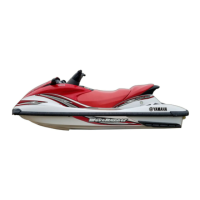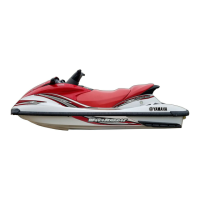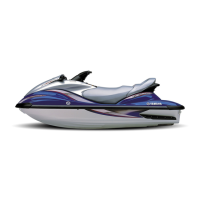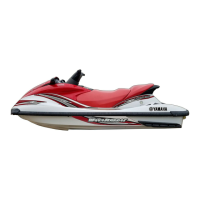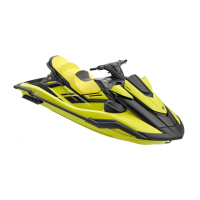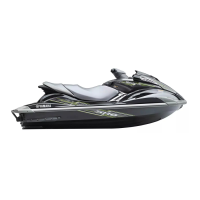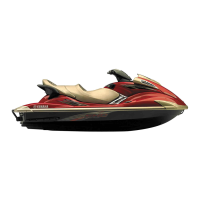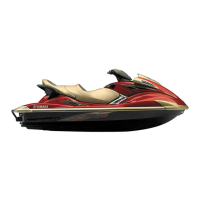Do you have a question about the Yamaha FX140 and is the answer not in the manual?
Locates and explains identification plates for the watercraft.
Details about the engine's emission control systems and labels.
Identifies and shows locations of crucial labels on the watercraft.
General safety guidelines for operating the watercraft.
Age, supervision, and training requirements for operators.
Guidelines for safe operation, speed, and maneuvering.
Essential gear and clothing needed for safe operation.
Lists essential safety and operational items to carry on board.
Warnings about potential dangers like exhaust fumes and hot surfaces.
Explains how the jet thrust propulsion and steering systems work.
Guidelines and precautions for water-skiing with the watercraft.
Basic navigation rules and right-of-way principles for waterways.
Specific rules for meeting, crossing, and overtaking other vessels.
Covers narrow channels, bends, and fishing vessel rules.
Explains the meaning of navigation buoys and markers.
Resources for further boating safety education and information.
Promotes responsible operation and respect for others and the environment.
Identifies key external parts of the watercraft with diagrams.
Details on operating seats, hood, fuel cap, switches, and levers.
Information on recommended fuel and engine oil types and safety.
A checklist of essential inspections before operating the watercraft.
Procedure and importance of the engine break-in period for performance.
Steps and precautions for safely launching the watercraft.
Detailed instructions and safety warnings for starting the engine.
How to properly stop the engine and safety considerations.
Steps to take when leaving the watercraft unattended.
Guidance on developing operating skills and understanding watercraft handling.
How to safely operate with passengers and their responsibilities.
Safe practices for starting the watercraft and avoiding collisions.
Procedures for starting and boarding in shallow water conditions.
How to safely start the engine and depart from a dock.
Techniques for boarding and starting in deeper water.
Steps for safely boarding passengers onto the watercraft.
Procedures for righting and restarting a capsized watercraft.
How throttle and handlebar input affect turning.
Methods for safely stopping the watercraft using water resistance.
Steps for safely bringing the watercraft ashore onto a beach.
How to safely approach and dock the watercraft.
Using reverse for low-speed maneuvering and docking.
Precautions for operating in rough water or choppy conditions.
Routine checks to perform after operating the watercraft.
Guidelines for safely securing and transporting the watercraft on a trailer.
Proper procedures for storing the watercraft, especially for long periods.
How to flush the cooling system to prevent clogs.
Points and procedures for lubricating moving parts.
Maintenance and safety for the fuel system components.
Inspection, charging, and storage of the watercraft battery.
How to properly clean the watercraft before storage.
General advice on performing maintenance and adjustments.
Importance of carrying the manual and tool kit.
Schedule for routine inspections and maintenance tasks.
Checking the fuel system for leaks and damage.
Procedure for changing engine oil and filter.
How to inspect and service the air filter element.
Checking the jet thrust nozzle for smooth operation.
Checking the shift cable and reverse gate for proper function.
Checking and adjusting the throttle cable free play.
How to inspect, clean, and gap spark plugs.
Specific locations and procedures for lubricating cables and components.
Checking battery electrolyte level and connections.
Caution against adjusting the factory-set fuel injection system.
How to check and adjust the engine trolling speed.
Procedure for replacing fuses in the electrical box.
Technical specifications for the watercraft model.
Guide to identifying and resolving common watercraft problems.
Steps to take in various emergency situations.
Details of the manufacturer's limited warranty coverage and exclusions.
Information on extended service plans for additional protection.
Locates and explains identification plates for the watercraft.
Details about the engine's emission control systems and labels.
Identifies and shows locations of crucial labels on the watercraft.
General safety guidelines for operating the watercraft.
Age, supervision, and training requirements for operators.
Guidelines for safe operation, speed, and maneuvering.
Essential gear and clothing needed for safe operation.
Lists essential safety and operational items to carry on board.
Warnings about potential dangers like exhaust fumes and hot surfaces.
Explains how the jet thrust propulsion and steering systems work.
Guidelines and precautions for water-skiing with the watercraft.
Basic navigation rules and right-of-way principles for waterways.
Specific rules for meeting, crossing, and overtaking other vessels.
Covers narrow channels, bends, and fishing vessel rules.
Explains the meaning of navigation buoys and markers.
Resources for further boating safety education and information.
Promotes responsible operation and respect for others and the environment.
Identifies key external parts of the watercraft with diagrams.
Details on operating seats, hood, fuel cap, switches, and levers.
Information on recommended fuel and engine oil types and safety.
A checklist of essential inspections before operating the watercraft.
Procedure and importance of the engine break-in period for performance.
Steps and precautions for safely launching the watercraft.
Detailed instructions and safety warnings for starting the engine.
How to properly stop the engine and safety considerations.
Steps to take when leaving the watercraft unattended.
Guidance on developing operating skills and understanding watercraft handling.
How to safely operate with passengers and their responsibilities.
Safe practices for starting the watercraft and avoiding collisions.
Procedures for starting and boarding in shallow water conditions.
How to safely start the engine and depart from a dock.
Techniques for boarding and starting in deeper water.
Steps for safely boarding passengers onto the watercraft.
Procedures for righting and restarting a capsized watercraft.
How throttle and handlebar input affect turning.
Methods for safely stopping the watercraft using water resistance.
Steps for safely bringing the watercraft ashore onto a beach.
How to safely approach and dock the watercraft.
Using reverse for low-speed maneuvering and docking.
Precautions for operating in rough water or choppy conditions.
Routine checks to perform after operating the watercraft.
Guidelines for safely securing and transporting the watercraft on a trailer.
Proper procedures for storing the watercraft, especially for long periods.
How to flush the cooling system to prevent clogs.
Points and procedures for lubricating moving parts.
Maintenance and safety for the fuel system components.
Inspection, charging, and storage of the watercraft battery.
How to properly clean the watercraft before storage.
General advice on performing maintenance and adjustments.
Importance of carrying the manual and tool kit.
Schedule for routine inspections and maintenance tasks.
Checking the fuel system for leaks and damage.
Procedure for changing engine oil and filter.
How to inspect and service the air filter element.
Checking the jet thrust nozzle for smooth operation.
Checking the shift cable and reverse gate for proper function.
Checking and adjusting the throttle cable free play.
How to inspect, clean, and gap spark plugs.
Specific locations and procedures for lubricating cables and components.
Checking battery electrolyte level and connections.
Caution against adjusting the factory-set fuel injection system.
How to check and adjust the engine trolling speed.
Procedure for replacing fuses in the electrical box.
Technical specifications for the watercraft model.
Guide to identifying and resolving common watercraft problems.
Steps to take in various emergency situations.
Details of the manufacturer's limited warranty coverage and exclusions.
Information on extended service plans for additional protection.
